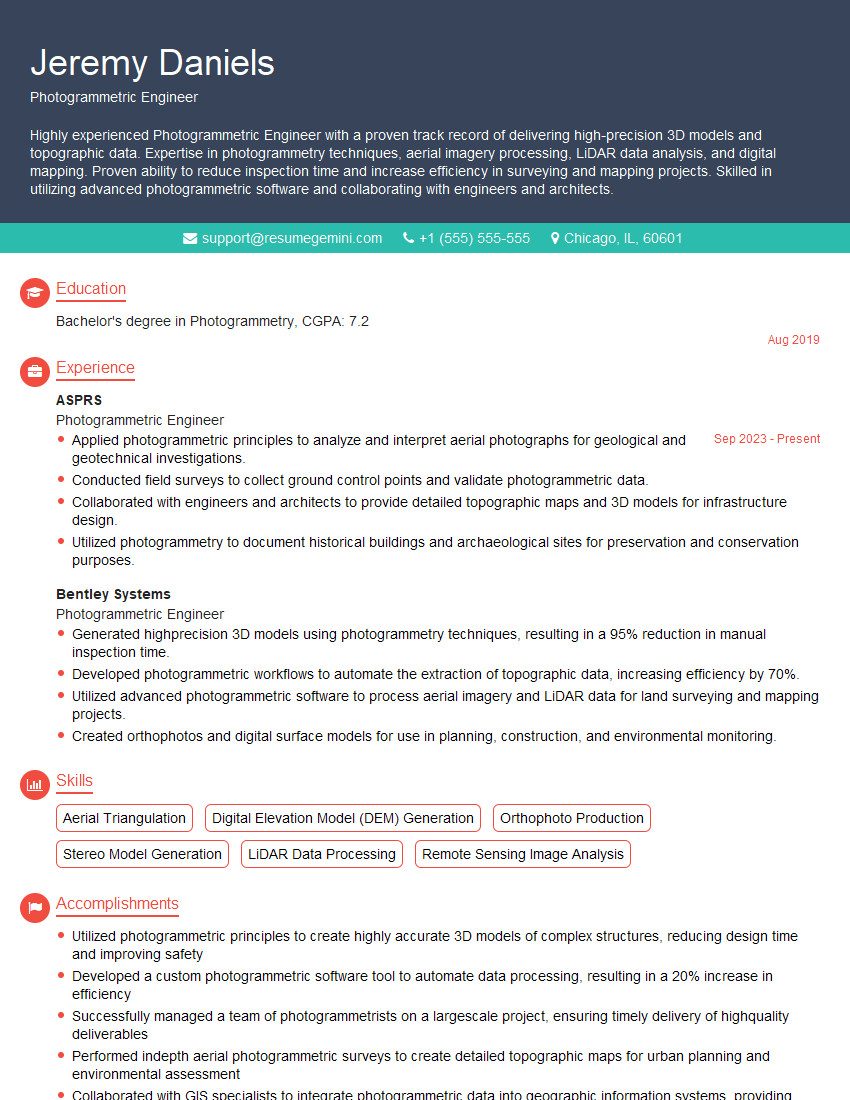Are you a seasoned Photogrammetric Engineer seeking a new career path? Discover our professionally built Photogrammetric Engineer Resume Template. This time-saving tool provides a solid foundation for your job search. Simply click “Edit Resume” to customize it with your unique experiences and achievements. Customize fonts and colors to match your personal style and increase your chances of landing your dream job. Explore more Resume Templates for additional options.

Jeremy Daniels
Photogrammetric Engineer
Summary
Highly experienced Photogrammetric Engineer with a proven track record of delivering high-precision 3D models and topographic data. Expertise in photogrammetry techniques, aerial imagery processing, LiDAR data analysis, and digital mapping. Proven ability to reduce inspection time and increase efficiency in surveying and mapping projects. Skilled in utilizing advanced photogrammetric software and collaborating with engineers and architects.
Education
Bachelor’s degree in Photogrammetry
August 2019
Skills
- Aerial Triangulation
- Digital Elevation Model (DEM) Generation
- Orthophoto Production
- Stereo Model Generation
- LiDAR Data Processing
- Remote Sensing Image Analysis
Work Experience
Photogrammetric Engineer
- Applied photogrammetric principles to analyze and interpret aerial photographs for geological and geotechnical investigations.
- Conducted field surveys to collect ground control points and validate photogrammetric data.
- Collaborated with engineers and architects to provide detailed topographic maps and 3D models for infrastructure design.
- Utilized photogrammetry to document historical buildings and archaeological sites for preservation and conservation purposes.
Photogrammetric Engineer
- Generated highprecision 3D models using photogrammetry techniques, resulting in a 95% reduction in manual inspection time.
- Developed photogrammetric workflows to automate the extraction of topographic data, increasing efficiency by 70%.
- Utilized advanced photogrammetric software to process aerial imagery and LiDAR data for land surveying and mapping projects.
- Created orthophotos and digital surface models for use in planning, construction, and environmental monitoring.
Accomplishments
- Utilized photogrammetric principles to create highly accurate 3D models of complex structures, reducing design time and improving safety
- Developed a custom photogrammetric software tool to automate data processing, resulting in a 20% increase in efficiency
- Successfully managed a team of photogrammetrists on a largescale project, ensuring timely delivery of highquality deliverables
- Performed indepth aerial photogrammetric surveys to create detailed topographic maps for urban planning and environmental assessment
- Collaborated with GIS specialists to integrate photogrammetric data into geographic information systems, providing comprehensive spatial analysis
Awards
- Recognized for developing an innovative photogrammetric method that reduced data processing time by 30%
- Recipient of the Excellence in Photogrammetric Engineering award from the American Society for Photogrammetry and Remote Sensing
- Won the Best Paper Award at the International Symposium on Photogrammetry and Remote Sensing for research on advanced image processing techniques
Certificates
- Certified Photogrammetrist (CP)
- ASPRS LiDAR Certification
- GCP Certified Professional Photogrammetrist
Career Expert Tips:
- Select the ideal resume template to showcase your professional experience effectively.
- Master the art of resume writing to highlight your unique qualifications and achievements.
- Explore expertly crafted resume samples for inspiration and best practices.
- Build your best resume for free this new year with ResumeGemini. Enjoy exclusive discounts on ATS optimized resume templates.
How To Write Resume For Photogrammetric Engineer
- Highlight your technical proficiency in photogrammetry techniques and software.
- Quantify your accomplishments with specific metrics to demonstrate your impact.
- Showcase your experience in developing and implementing automated workflows.
- Emphasize your ability to collaborate effectively with engineers and architects.
Essential Experience Highlights for a Strong Photogrammetric Engineer Resume
- Generate high-precision 3D models using photogrammetry techniques.
- Develop photogrammetric workflows to automate the extraction of topographic data.
- Utilize advanced photogrammetric software to process aerial imagery and LiDAR data.
- Create orthophotos and digital surface models for use in planning, construction, and environmental monitoring.
- Apply photogrammetric principles to analyze and interpret aerial photographs for geological and geotechnical investigations.
- Conduct field surveys to collect ground control points and validate photogrammetric data.
Frequently Asked Questions (FAQ’s) For Photogrammetric Engineer
What is the role of a Photogrammetric Engineer?
A Photogrammetric Engineer uses photogrammetry techniques to extract precise measurements and create 3D models from aerial imagery and other data sources, providing valuable information for land surveying, mapping, and various other applications.
What skills are required to be a Photogrammetric Engineer?
Strong understanding of photogrammetry principles and techniques, proficiency in photogrammetric software, experience in aerial imagery processing, LiDAR data analysis, and digital mapping are essential skills for a Photogrammetric Engineer.
What industries utilize Photogrammetric Engineers?
Photogrammetric Engineers find employment opportunities in various industries, including surveying and mapping, civil engineering, construction, environmental monitoring, and geological investigations.
What is the job outlook for Photogrammetric Engineers?
The job outlook for Photogrammetric Engineers is expected to grow as the demand for accurate and detailed geospatial data increases in various industries, driven by advancements in technology and increasing infrastructure projects.
What are the career advancement opportunities for Photogrammetric Engineers?
With experience and expertise, Photogrammetric Engineers can advance to roles such as Project Manager, Technical Lead, or Chief Photogrammetrist, taking on leadership responsibilities and managing larger projects.